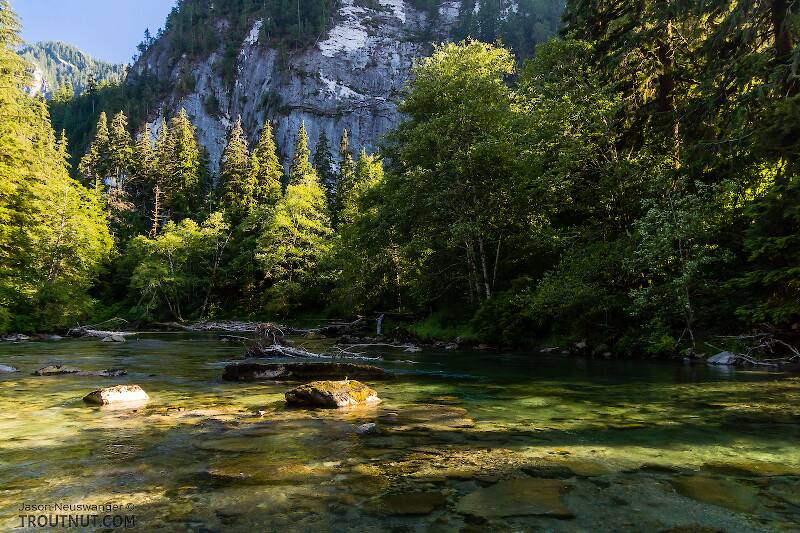
Salmonflies
Pteronarcys californica
The giant Salmonflies of the Western mountains are legendary for their proclivity to elicit consistent dry-fly action and ferocious strikes.


Stonefly Species Sweltsa townesi (Sallflies)
Species Range
Physical description
Most physical descriptions on Troutnut are direct or slightly edited quotes from the original scientific sources describing or updating the species, although there may be errors in copying them to this website. Such descriptions aren't always definitive, because species often turn out to be more variable than the original describers observed. In some cases, only a single specimen was described! However, they are useful starting points.
Description from GBIFthe Global Biodiversity Information Facility
Source: A Scanning Electron Microscopy Study Of The Epiprocts Of Western North American Sweltsa (Plecoptera: Chloroperlidae)
Male epiproct. Total length ca. 500 - 530 µm, basal width ca. 125 - 150 µm, greatest width ca. 245 - 250 µm. Epiproct sagittate in dorsal aspect with thick tip slightly upturned and bearing narrow groove which extends from base to ca. 90 - 110 µm from apex (Figs. 19 - 22). Dorsal surface bearing short, multifilament setae (Fig. 23); ventral surface glabrous. Dorsal process. Located on tergum 9. Total width ca. 160 - 180 µm, median notch shallow with truncate floor, notch width ca. 80 - 90 µm. Lobes of process triangular in outline (Fig. 24).
Source: Studies On Sweltsa Townesi And A New Species, Sweltsa Salix, From Northern California (Plecoptera: Chloroperlidae)
Male. General body color yellow with brown markings. Head yellow, ocellar rings dark brown; brown mark forward of anterior ocellus to frontal margin masking center of M line; brown behind eyes. Pronotum wider than long, yellow with dark brown margins and rugosities. Abdomen with dark brown median stripe from tergum 1 to the anterior half of tergum 8. Lateral brown marks anteriorly on at least segments 1 - 4; anteromedial transverse, anteriorly sclerotized, scalloped ridge on tergum 9, often with unevenly crenulate margin. Epiproct tip chocolate brown; in dorsal aspect (Fig. 1) spatulate, ca. twice as long as greatest width; narrowing slightly from base then gradually widening to its greatest width at 2 / 3 length before narrowing to a bluntly pointed apex (Fig. 2); narrow median groove running from base to near apex (Figs. 1, 2, 5). In lateral aspect (Figs. 3, 4) narrow at base with club shaped apex; dorsal margin nearly straight with slight dip where median groove terminates, before rising to a club-shaped apex; ventral margin nearly straight in basal 1 / 3, becoming declivent at ca. 45 °, then recurved to apex. Aedeagus membranous (Figs. 7, 8), tubular basally, expanded abruptly into thick, semicircular, plate-like process, with horn-like lateral extensions; dorsal margin bearing paired finger-like lobes medially, with an elongate covered orifice below the lobes (Figs. 7, 8) much like Sweltsa exquisita (Frison) in Kondratieff and Baumann (2009) Figs. 8, 9.
Female. General body color and markings similar to male but median brown mark on tergum 8 mostly restricted to anterior margin. Subgenital plate roughly hexagonal (Fig. 6), usually darker than surrounding sterna, hirsute, elevated anteriorly and centrally, posterior margin straight to slightly emarginate, extending at least ½ over sternum 9.
Start a Discussion of Sweltsa townesi
References
- Baumann, Richard W. 1975. Revision of the Stonefly Family Nemouridae (plecoptera) : a Study Of The World Fauna At The Generic Level. Smithsonian Contributions to Zoology undef(211): 1-74.
Stonefly Species Sweltsa townesi (Sallflies)
Species Range
Common Names
Resources
- NatureServe
- Integrated Taxonomic Information System
- Global Biodiversity Information Facility
- Described by Ricker, W.E. (1952) Systematic Studies in Plecoptera. Indiana University Publications Science Series 18, 1–200.

